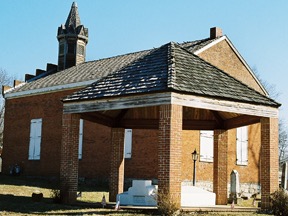Steeling Moses
May 2020

It began when I left the comfort of Route 66. Driving south into the rugged hills, I entered the land of Moses.
Most people are aware Moses never made it to the Promised Land, a detail that disturbs more than a few Texans. Technically, Moses Austin made it to Texas, but he didn’t stay. In 1821, Moses was the first person to get permission from the governor of Spanish Texas to establish an Anglo-American colony there, leading a group of 300 families from Potosi to San Antonio de Bexar. He returned to Missouri and died soon after.
His remains rest in a cemetery in the middle of downtown Potosi.
The county where he’s buried is named for the Father of Our Country. But there’s visible proof that Moses Austin is Washington County’s favorite son. And they intend to keep it that way despite the nefarious intentions of a few Texans.
Encased beneath a slab of concrete the size of a carport, Moses has resisted body snatchers so far. Lone Star historians say Texas made overtures to remove Moses from a “neglected cemetery” and repatriate him with his son, Steve, in Austin.
Potosi historians are a bit more blunt. They tattle on Texas undertaker Thurlow Weed, who they say drove a hearse to Potosi in the early 1930s and started chipping away at Moses’ tomb. The marshal and a posse of enraged citizens sent Weed tumbling back to Texas, bearing no pall. Texas historians say there was no posse and that Weed returned to Texas with a Potosi City Council resolution opposing the move.
In 1938, both parties agree, the governor of Texas made one more attempt to get Moses. Texans say the Lone Star secretary of state came to make one last plea for the body, but instead came away recommending that Moses rest in peace in Potosi. Local tales persist that the Texas official came to apologize. But regardless of the purpose of this final attempt, Potosi is the only American town to repel a Lone Star invasion.
Moses is the grandfather of Texas, not Missouri. But among his Missouri accomplishments, he donated land for this Washington County seat of government. Named for a Bolivian silver mining town, Potosi is a South American Indian word for “place of much noise,” a harbinger to the Moses grave dispute. Backwards, the word Potosi comes one letter shy of spelling isotope, appropriate for the region’s heavy metal mining. In the realm of heavy metal, Moses Austin was a rock star. He established the first reverberatory smelter west of the Mississippi. And like most rock stars, his rise and fall was mercurial. A bank failure and recession in 1819 forced him to close his lead mining business, and he turned his attention to “the Texas Venture.”
Dipping into the land of Moses’ bones, I neither saw nor smelt, nor heard heavy metal, but heavy woods stretched in every direction over these foothills to the St. Francois Mountains. Route 47 snakes down to join Highway 21, and like two old friends, they share a path for five twisting miles. The trail could be named Memory Highway, because every two miles or so, an Adopt-A-Highway sign declares “In Loving Memory of [YOUR NAME HERE].” The most intriguing dedication is “In Memory of Beef.” Well, then. Suffice it to say that this road has delivered more than one species to glory. It’s just another indication that the end is near.
Moses knew that.
But even as he believed the end justified his means, Thurlow Weed couldn’t dislodge the grandfather of Texas from his final resting place.
Visit JohnDrakeRobinson.com to find out where to purchase a copy of his latest book, Souls Along The Road.
